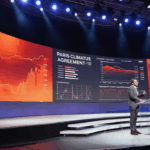This article is part of a series republished via the Council of Business and Society platform.
The Covid-19 crisis provided additional scientific evidence around natural capital. A Task Force on Nature-related Financial Disclosures should deliver a consensual framework for companies and investors to report on how they preserve biodiversity by the end of 2023. That is all very well, but with exponential biodiversity depletion, the faster we move, the better. That said, a reporting framework does not necessarily constitute a clear business case. Here is why we encourage companies and investors to change their mindset on nature.
Understanding the Issues Attached to Biodiversity and Nature-Related Financial Disclosures
The situation of land, water and marine ecosystems is concerning. Insect and bird populations are plummeting. Biodiversity faces numerous pressures, from land artificialization, to the fragmentation of natural environments, climate change, chemical, light and acoustic pollution.
We basically don’t know 95% of fauna and flora species of our planet. Meanwhile, our development and human impacts are quickly depleting a significant portion of nature… Much more than we even know. This is primarily a problem for human beings, way more than for nature itself. Nature has in fact proven its resilience and capacity to adapt in the past billions of years.
Addressing biodiversity is therefore closely related to the sustainability of human life on Earth, more than protecting the planet. For the human kind, the question arises as to when the exponential fall in biodiversity is likely to cause a sudden disruption that challenges our place on Earth.
Yet there are glimmers of hope. Set against the backdrop of the global Covid-19 pandemic, the coming months should provide much-needed time to refine our scientific evidence. This could perhaps also bring about a business and political environment more receptive to the need for transformative change. This in turn may bolster interest for preserving species, ecosystems and genetic diversity. There is indeed much more to be said on the broader intersection of biodiversity conservation and human society. Much like the interdependence of biodiversity and climate policy.
The Business Case For Addressing Biodiversity… And Fast
For business and investors, the strategic case for addressing biodiversity is threefold:
1. It’s A Matter of Resilience
Luxury products have a clear track-record of using rare species (e.g.: snake skin, wild fur…) to craft unique consumer goods. When sourcing a rare material became more difficult, luxury brands switched to other materials and kept depleting species.
This has slowly evolved in the past decade, however. Not so much because consumers suddenly expressed concerns. Rather because industry found it complicated to adapt design and processes to unpredictable sourcing activities. On top of that came growing regulatory pressure, further encouraging industry-wide change. Resilience — in the sense of adapting business to a new regulatory normal — encouraged luxury companies to increasingly care for biodiversity and explore sustainable sourcing of raw materials. This is far from satisfactory, yet luxury is often cited as the leading opinion.
Many other industries in food, healthcare, forestry, manufacturing are heading in a similar direction. They understand that biodiversity consideration is increasingly shrinking raw material sourcing opportunities. As a result, they are actively exploring innovative substitutes to keep using materials whilst curbing biodiversity-depleting activities. They are working on the resilience of their very own business models.
2. It’s Also A Matter of Acceptability
A lot of business models rooted in the past are no longer capable to cope with the pressure they face. That is particularly true when it comes to biodiversity preservation.
Erecting a greenfield infrastructure used to be a proof of development in emerging economies. After all, the government in Brazil has long claimed development comes in the form of roads. That is now dated. In developed economies, erecting new roads and infrastructures is becoming challenging. Land artificialization is indeed increasingly competing with other ways to allocate the very same land. Land allocations could in fact be preferred to more biodiversity-friendly activities — forestry for instance. They may also lead to other biodiversity-adverse economic activities, such as intensive agriculture, construction and housing, recreational areas for sport and entertainment.
All in all, acceptability is increasingly driven by climate considerations. This could very well make life difficult for carbon-heavy developments, without necessarily fostering biodiversity.
3. New Approaches to Value Creation
This is a consideration we find most interesting at Ksapa. Cynically, it is a good way to align the interests of nature and business.
Harking back to the good old principle of offer and demand, the more biodiversity becomes valuable, the more biodiverse land becomes valuable. A random supermarket often plants a small wooden plot between car parking areas. It can easily consider that small wooden parcel is a vague space that could be optimized to park more vehicles — and bring a few more consumers to the supermarket. Or, in context of growing digitalized transactions with consumers and less traffic in supermarket anyway, the very same supermarket may look at the very same wood as a valuable and therefore sanctuaried forest to preserve some (albeit limited) biodiversity. It follows this would lend this piece of land the value of unbuilt land. That supermarket could perhaps explore options to sequester carbon through that forest plot — and generate carbon credits in the process.
At any rate, there are solutions value unbuilt land. This could by far exceed the value of few more parking spaces. This is obviously just an example, but time is clearly ripe to change mindsets, adopt a biodiversity lens and explore the concept of land valuation differently. Such is the way forward to protect nature while creating long-term value.
How can Companies and Investors Value Biodiversity?
Companies and investors are under growing pressure to step up zero deforestation action. Many made clear commitments since 2015. We are not aware of a single target met to date. These approaches not amounted to much, nor have they bolstered corporate credibility. They certainly have not mitigated biodiversity depletion risks. In short, they are a waste of time.
Instead, there are very concrete options for companies and investors to walk the talk and commit to do business, whilst preserving biodiversity. Here are but 3 options:
1. Select Sensitive Materials And Seriously Address Core Issues
2. Explore All the Opportunities Circularity Offers
Sustainable forest management is a sound example to demonstrate how to use nature-based products in a sustainable manner.
Generally speaking, though, the rule of thumb is circularity drastically lowers pressure on nature. The more we reuse, the more we repurpose, the less we activate pressure on nature and its remaining valuable biodiversity.
There are many ways to explore circularity. One that is often well understood (but has yet to be fully brought to scale) is linked to material or product circularity. Recycling PET from plastic bottle to make PET-derived fibers can allow businesses to craft T-shirts, for example.
Another dimension that is less obvious comes with the repurposing of land allocation to preserve biodiversity. This may be less socially acceptable but incentivizing rebuilding instead of granting new lands for additional housing may for instance serve a social purpose while curbing land artificialization.
3. Put a Price on Valuable Land Areas
We have worked on the concept of ecosystem services, which has overall never proven to move from pilot to scalable program. There are key learnings to derived from those pilots, however.
It overall costs less to benefit from externalities rather than try to make the very same externalities happen. In other words, the cost of preserving a nature-based systems — say, to filter water or enable bees to make honey — is lower than rebuilding a similar man-made environment. That said, that concept is far too abstract for a number of businesses. That is because they do not directly deal in raw materials. Either that or they process more complex input materials. They could also be tertiary activities with no direct value creation opportunities linked to nature-based materials.
Building on carbon discussions, they could still get a sense of whether and how they could value biodiversity. From there, they would be in a position to track whether and how an increase in biodiversity pricing could impact their margins and competitiveness in the long run.
Why Does A Nature-Related Financial Disclosure Framework Even Matter?
All of the abovementioned solutions hinge on baseline data. What is my business accountable for? For the sake of comparability, how is my business doing compared to others? This calls for levelling the playing field, to frame taxonomy and reporting.
Conservation scientists rightly insist post-2020 biodiversity goals must be ambitious. Yet bold, global targets are only a first step. They can lack meaning or even lead to negative outcomes for lack of adequate spending and scientific infrastructure for national and local-level implementation and monitoring.
The 2010 Aichi Targets were clearly not met. They show most parties did not set effective national targets in accordance with the Aichi agenda. Worse, insufficient investments, knowledge and accountability hampered implementation. Doing better requires a substantial increase in finance for biodiversity conservation as well as compliance and accountability monitoring systems.
Zooming In On Biodiversity Investment
The Biodiversity Finance Initiative tracks national-level biodiversity investments. A recent report concluded to insufficient investment mechanisms, which generated insufficient interest for biodiversity by public authorities and business decision-makers. It went on to stress public spending on biodiversity is increasing overall, but wealthier countries — as traditionally characterized by the gross domestic product (GDP) measure of ‘wealth’ — spend proportionally less on biodiversity than lower-GDP nations. This must change. Higher-GDP nations are increasingly accountable for ‘offshore’ biodiversity loss through trade and must consequently pay for, and reduce their remote impacts.
The independent Dasgupta Review on the Economics of Biodiversity further stressed the need for more equitable spending to conserve and restore nature. The landmark document emphasizes reversing the trend of biodiversity loss now will be less costly than to delay any longer. In short, it identifies deep-rooted institutional failures as the heart of the problem of biodiversity loss and calls for a fundamental change in our definition of wealth. We must step away from the mindset of unsustainable growth characterized by GDP measures and move decidedly toward inclusive growth that fully recognizes natural assets.
This sober and evidenced recognition of the need for transformed ideas of wealth and progress is welcome. It should be complemented by a pragmatic acceptance that rich nations — by current definitions — should pay more and immediately to conserve and preserve nature. Implementing both transformative change and rapid spending on biodiversity seems difficult in the midst of the Covid-19 pandemic, what with widespread individual economic hardship in many ‘wealthy’ nations. It will therefore require extreme political will not to fall back on retrograde economic fixes.
Conclusion
Interestingly, it is somewhat easier to measure biodiversity depletion than carbon emissions. One may value species loss or non artificialized land in much more concrete terms than greenhouse gas ton equivalents. The truth is our increasingly urban and tertiary activities have made it more difficult for policy, finance and business decision-makers to put skin in the game — despite being the most influential on the matter.
Given our exponential biodiversity depletion — which climate change further worsens — we will see more impacts on our daily lives in the coming years. There are already proven correlations between deforestation and pandemics. Business and investors will be increasingly scrutinized.
A reporting framework should generate better disclosure and comparability by 2024. Until then, owing to market and regulatory pressure, Ksapa encourages investors and businesses to explore biodiversity considerations with a triple lens of resilience, acceptability and value creation.
Author of several books and resources on business, sustainability and responsibility. Working with top decision makers pursuing transformational changes for their organizations, leaders and industries. Working with executives improving resilience and competitiveness of their company and products given their climate and human right business agendas. Connect with Farid Baddache on Twitter at @Fbaddache.






